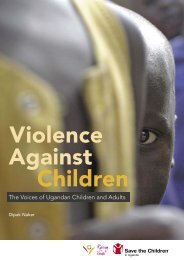CA C 1 - Raising Voices
CA C 1 - Raising Voices
CA C 1 - Raising Voices
You also want an ePaper? Increase the reach of your titles
YUMPU automatically turns print PDFs into web optimized ePapers that Google loves.
<strong>CA</strong>C 1<br />
270<br />
<strong>CA</strong>C 1<br />
“You walk out of your house and are now in the street, seeing other people. You see a woman<br />
washing clothes. What is life like for her? Does her husband treat her well? (Pause)<br />
“You see a young woman on her way to work. She has a bruise on her face. How did she get that<br />
bruise? Does she have support from people around her? Who does she talk to about the violence in<br />
her life? (Pause)<br />
“You see a pregnant woman with three young children beside her. She looks sad and tired. Why do<br />
you think she is sad? How much say does she have in what happens to her? (Pause)<br />
“You continue to walk down the street. What do you see? Do you see women carrying buckets of<br />
water? Do you see women taking care of children? What are the women doing? How many<br />
different things do you see women doing that are unpaid? Do you see men? What are they doing?<br />
(Pause)<br />
“You see an old woman with wrinkled skin and grey hair. She is sitting on the ground begging. How<br />
did she get there? What is the story of her life? What has she been through? (Pause)<br />
“You see a young girl playing next to the old woman. She is wearing a torn dress and is sitting in<br />
the dirt. What will her life be like? What can she hope for in the future? (Pause)<br />
“Now, imagine that you travel forward in time. Imagine that your organisation or community has<br />
been working to prevent violence against women for some years, and the work has been well<br />
received. Women’s rights are now being respected and their needs are being taken more seriously.<br />
There have been positive changes for women in the community.<br />
“Remember the young girl in the torn dress who was playing next to the old woman. Imagine that<br />
you see her again, now grown-up. What is her life like as an adult? Is it similar to that of the<br />
women you saw earlier or is her life different? Have things improved? (Pause)<br />
“Look around in the community, what do you see? How are women treated differently as a result of<br />
the success of your work? How have women’s lives changed? Take a few moments to imagine this.<br />
Think of the woman who was washing clothes. Remember the young woman with the bruised face.<br />
Think of the old woman begging. How will their lives have changed? Are they treated with respect?<br />
Do they have a say in their families? Are they able to make decisions for themselves? (Pause for a<br />
while to allow participants to imagine this in detail).<br />
“When you are ready, breathe in slowly and breathe out slowly, releasing tension in your body. Take<br />
two more deep breaths. When you are ready, slowly open your eyes and come back to the group.”<br />
Part C – Discussion (45 min)<br />
1. On a large wall, stick up four sheets of flipchart side-by-side. Title the first one “Here” and the last one<br />
“There.” Do not write anything on the two pieces of flipchart in the middle.<br />
2. Ask the participants about the images they saw when they imagined the present day reality for women?<br />
Ask them to share feelings and circumstances of the women they imagined. Ask probing questions to<br />
bring out what women’s lives are like in their community. Ask participants: “What does it mean to be a<br />
woman in your community?”<br />
Mobilising Communities to Prevent Domestic Violence

















